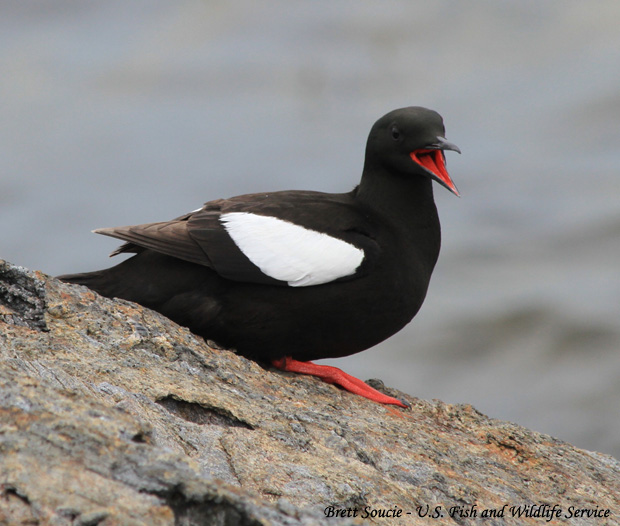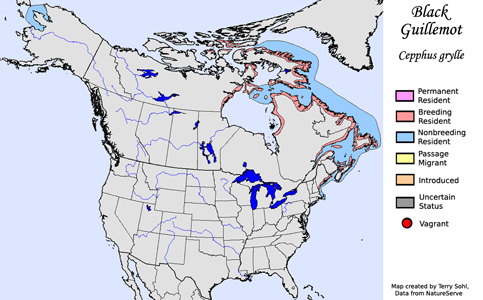| Length: 13 inches | Wingspan: 21 inches | Seasonality: Non-resident in South Dakota |
| ID Keys: Breeding birds are black with white wing patch. Inside of mouth and feet are bright red. Non-breeding birds mostly white with dark barring on upperparts. Underwing is white with black edging. | ||
 The
Black Guillemot is the eastern North American equivalent of the Pacific's
Pigeon Guillemot. While
primarily found in the cold northeastern coastlines of North America, they
also can be found in northern Alaska, including in areas where the Pigeon
Guillemot is found. The primary distinguishing characteristic between
the two species in breeding plumage is white wing patch (see below).
Non-breeding birds are anything but "black" in non-breeding plumage, as they
are mostly white, with some dark barring on their upperparts.
The
Black Guillemot is the eastern North American equivalent of the Pacific's
Pigeon Guillemot. While
primarily found in the cold northeastern coastlines of North America, they
also can be found in northern Alaska, including in areas where the Pigeon
Guillemot is found. The primary distinguishing characteristic between
the two species in breeding plumage is white wing patch (see below).
Non-breeding birds are anything but "black" in non-breeding plumage, as they
are mostly white, with some dark barring on their upperparts.
Habitat: Found relatively close to shore at most seasons, although non-breeding birds may be found on the edges of pack ice far from shore. Nesting occurs on rocky shorelines and islands, or in other coastal locations with adequate protected sites for nesting.
Diet: Primarily feeds on fish and crustaceans, with diet dependent upon season and location. They will also sometimes feed on insects, marine worms, and mollusks.
Behavior: Forages by swimming underwater after prey.
Nesting: The nest of a Black Guillemot is in a protected spot on the ground, such as a rocky crevice or amongst driftwood. The nest itself is typically just a thin layer of pebbles, or they may just lay eggs directly on a shallow scrape in the ground. The female lays 1 or 2 eggs, and both parents help to incubate them. When the eggs hatch, both parents help to feed the young. The young leave the nest after 4 to 6 weeks, moving to the water, but still unable to fly.
Interactive eBird Map: Click to access an interactive eBird map of Black Guillemot sightings
Song: They are quiet away from breeding grounds, but during the breeding season they have a variety of high-pitched whistles and thin screams.
Migration: Most Black Guillemots move just short distances in winter, staying in and around breeding areas if open water is available. There is some southern migration for some populations, with birds reaching as far as coastal New England in winter.
Similar Species: Very similar to the Pigeon Guillemot. The two species are most easily differentiated by looking at the white wing patch of breeding birds. On the Pigeon Guillemot, a dark bar is found over the lower part of the white wing patch. The white wing patch on the Black Guillemot is unmarked, a simple continuous field of white.
Conservation Status: Populations are large, they are found over a very wide geographic area, and they appear to be increasing in number. The IUCN lists the Black Guillemot as a species of "Least Concern".
Further Information: 1) Alaska Seabird Information Series - Black Guillemot
2) BirdLife International - Black Guillemot
3) Audubon - Black Guillemot
Photo Information: Photo taken by Brett Soucie with the U.S. Fish and Wildlife Service. Photo licensed under Creative Commons Attribution 2.0 Generic license.
| Click below for a higher-resolution map |
 |
| South Dakota Status: Non-resident in South Dakota |
Additional Black Guillemot Photos (coming soon!!)
